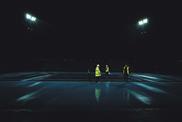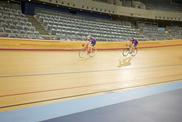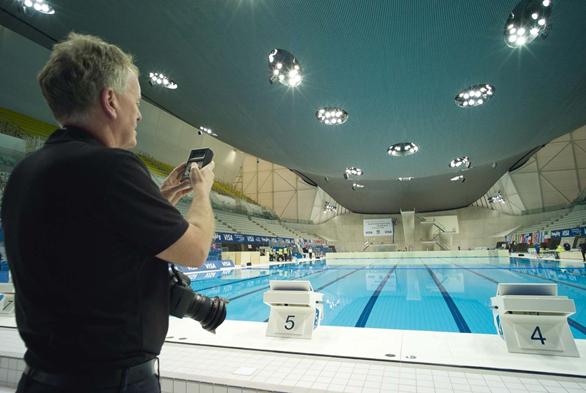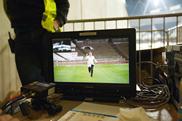



Rapid developments in high definition television and the advent of super slow-motion replays presented some interesting challenges for the lighting designers working on the Olympic venues. Amanda Allen reports
Olympic fever reached its climax last month as the eyes of the world were fixed on London 2012. With more than 20 million Britons tuning in just to watch Usain Bolt storm the 100m final, you get a sense of the scale of the televisual element of the Games and just how important it was to get every shot perfect.
Unsurprisingly, the lighting at Olympic venues has a huge bearing on the quality of broadcast images and for the past 12 months the venues’ lighting schemes have been in training for ‘the greatest show on earth’.
The design of the various lighting schemes has of course been under way for considerably longer than 12 months, but rapid advancements in the field of camera technology meant that changes were being made to completed schemes right up to the last minute.
Happold Lighting was involved in the lighting of the Olympic Stadium. Kevin Grant, discipline director, explains the consultancy’s early approach: “We began work on the Olympic Stadium back in 2007, long before the broadcasting requirements for London 2012 were known. The closest precedent we could work to was the Beijing Olympics, which were about to take place, so initially we based our design on their broadcast requirements.”
This was typical for the majority of Olympic venues, which were mostly completed or near completion by the time the London 2012 Olympic Broadcasting Services agency was appointed. Once appointed, the OBS, which is part of LOCOG, set about fine-tuning the lighting for broadcast and procured the help of Arup Lighting to advise on all venues.
The flicker factor
Many televised sporting events require super-slow-motion replays and for these flicker has to be kept to an absolute minimum. This presented the biggest lighting challenge.
Giulio Antonutto, associate with Arup Lighting, says: “This was one of the biggest elements to tackle. As soon as you have 150 or more frames per second, you need to cross the phases properly if you use traditional equipment – magnetic ballasts, for example.”
Electronic ballasts solve the flicker issue completely and Antonutto reveals they were indeed specified for the Aquatics Centre, but were not available at the time of installation. He says: “We used a traditional cross-phasing technique to achieve near-perfect flicker-free conditions in the main pool hall but, with sports such as diving, flicker can present a real problem. The electronic controls did become available at a late stage in the programme, so we decided to change some of the ballasts in the diving area.”
In contrast, a decision was taken to replace all of the magnetic ballasts in the Velodrome, giving an entirely flicker-free result.
Mike Simpson, technical director of Philips Lighting, worked on the project. He says: “Flicker had to be eliminated from the Velodrome. People are obviously moving very fast and, if you want to capture a cyclist doing 70kph in high definition, slowmotion television, you really do need constant light. What could be achieved here with rephasing wouldn’t have been enough, so all the control gear was switched to electronic gear.”
In addition to the speed involved in the cycling events it was the issues associated with the tight geometry of the track and its glossy surface that led Arup to look closely at the venue lighting, taking into account its 3D geometry to overcome any issues of flicker and glare.
In the Olympic Stadium there was also a requirement to reduce flicker but not to the same extent as in the Velodrome or Aquatics Centre. “When we measured the amount of flicker in the stadium, initially we were getting a reading of about 20 per cent. Through rephasing we were able to reduce that to 6 per cent,” says Antonutto.
Designing glare out
Other elements of a scheme that can have a major effect on broadcast quality are the balance of illumination, glare and focus on the field of play.
Skip glare especially was an issue in the Velodrome. “This is much more of an issue when you’re working with a glossy surface, such as we found [with the track] in the Velodrome. When the camera pans over an affected area, the shot is white and the action lost. We had to carefully adjust the fittings to minimise this problem and proposed that electronic ballasts be installed throughout,” says Antonutto.
This ‘loss of action’ is one of the main things that can go wrong during a broadcast. But, similarly, a focus on anything other than the field of play can present problems.
“It’s important that the action on the field of play is distinguished from the action among the spectators. You want to see the action on the field of play, not the spectator in the background, so the light level on the spectator has to be lower than that on the athlete,” says Antonutto.
Striking a balance
Lighting that is sympathetic to the field of play, as well as achieving a balance of illumination in the arena, are issues that need to be considered at the conceptual stage of a design.
“One of the things that a broadcaster needs is a balance between vertical and horizontal illumination,” explains Antonutto. “Some people don’t consider the indirect component of the lighting, so at the design stage for the vertical they consider only the direct component, ignoring what is reflected from the floor. That forces them to use a very steep angle, which can cause glare. If you considered the light that bounces off the floor, it contributes a lot to the vertical illumination.”
For both Arup and Philips, the lack of an up-to-date broadcast lighting standard presented a challenge when designing for London 2012. Simpson believes one thing to be learnt from the Games is that the standard should be rewritten.
He says: “The CIE Broadcasting Specification, the one we were most referred to, is written in a general way, without concrete figures. We are now at a point where we can get something down on paper. The standard simply says that you should minimise flicker. You can minimise flicker from 100 to 50, but that’s still unacceptable to the broadcaster.”
Antonutto adds: “On the other hand, CIE states the requirement for minimising the flicker by mixing phases and achieving equal illuminance for each phase. This is a simple rule of thumb that ensures good results when correctly applied, but unfortunately the majority of designers interpret this as a simple electrical balance, resulting in a level of flicker that is no longer acceptable with today’s advanced camera technology.”
But, with the rapid advancements that have taken place in camera technology in the past four years, would a new standard not also become obsolete in a short space of time? Not so, according to Simpson: “We’ve had quite a leap in shutter speeds in the past few years but a broadcaster is never going to need more than 500 frames per second. If you went much faster than that, the clip would become very hard to use in a live transmission. If you wanted to watch Tom Daley diving at 1,000 frames per second, it would take you many minutes to watch the footage back.”

